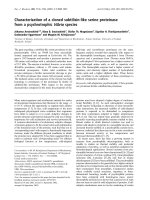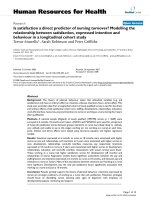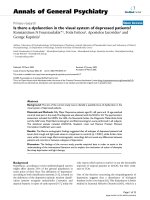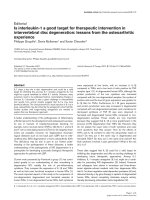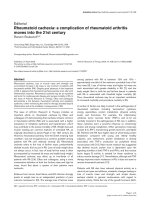Báo cáo y học: "Is fibromyalgia a cardiovascular disease? A comment on Martinez-Lavin’s review ‘Stress, the stress response system, and fibromyalgia’" ppsx
Bạn đang xem bản rút gọn của tài liệu. Xem và tải ngay bản đầy đủ của tài liệu tại đây (37.02 KB, 2 trang )
Page 1 of 2
(page number not for citation purposes)
Available online />Fibromyalgia syndrome (FMS) is a mysterious condition with
uncertain physiopathogenesis. Despite its hermeneutic
problems, FMS and related afflictions are responsible for the
majority of family medicine and rheumatological medical office
appointments. In spite of the skepticism of some, it seems
that the medical science community has accepted FMS as a
valid, unique clinical diagnosis and the main theory explaining
it (the central sensitization model (CSM)) may relate to many
chronic pain states.
The CSM actually labels not a single unified hypothesis but,
rather, a group of evidence-based central nervous system
(CNS)-centered physiopathogenesis hypotheses for FMS. It
constitutes the only model capable of explaining the majority
of symptoms of FMS and predicts that CNS-acting agents
are the most effective drugs in its treatment. Despite its
success, many questions still need clarifying. What is the
exact nature of the CNS alteration that is expressed as central
sensitization? Why does it occur? What are its causes? And
are there any genetic alterations that predispose to it?
Martinez-Lavin’s review on FMS and dysautonomia [1]
proposes a model that could explain FMS in terms of a
sympathetically maintained neuropathic pain syndrome. It has
the virtue of explaining the possible mechanisms behind CSM.
Besides its conceptual and experimental gaps, we must not
discard it without meticulous scrutiny through experimentation.
The effort to get closer to a mechanistic, complete model of
the CSM and FMS will certainly be rewarding since the need
for a theoretical framework is critical in the study of FMS and
other related chronic pain states.
We recently reported our own FMS causation model based
on the experimental findings of Martinez-Lavin and others [2].
Briefly, we noted that there is probably a close relationship
between FMS and related diseases and cardiovascular
alterations, especially dysautonomia. The pattern, as noted
also by Martinez-Lavin, involves not only sympathetic basal
overactivity, but also sympathetic blunted responses to
stimuli such as orthostatic challenge. Stewart and colleagues
[3] have published many articles on orthostatic intolerance
and its relationship to chronic fatigue syndrome, a disease
closely related to FMS. His team and others think that
dysautonomic alterations in orthostatic intolerance and
chronic fatigue syndrome (described as similar to the findings
associated with FMS) stem from microvascular reactivity
alterations that lead to venous pooling in dependent
extremities. Their main concept is of a ‘relative thoracic hypo-
volemia’ that determines secondary dysautonomia in ortho-
static intolerance and probably chronic fatigue syndrome.
Based on these and other findings, we proposed a cardio-
vascular FMS model, relating cardiovascular and nociception
neural modulation as a possible cause of the CSM.
Do the experimental data as reviewed by Martinez-Lavin
provide support for a cardiovascular model of FMS and
related diseases? It may be so, but we need more
experimentation to try these new ideas. Recent publications
suggest that FMS patients more frequently have metabolic
syndrome, and a hyperadrenergic state with blunted
epinephrine secretion [4]. In addition, elevated body mass
index correlated with secondary FMS [5]. Finally,
neuroimaging techniques are disclosing a possible
relationship between FMS and neurodegeneration [6]. Could
it be that FMS patients have a neurovascular disease
associated with CSM? Only time and more knowledge will
tell.
Letter
Is fibromyalgia a cardiovascular disease? A comment on
Martinez-Lavin’s review ‘Stress, the stress response system, and
fibromyalgia’
Francisco Hélder C Félix
1
and Juvenia Bezerra Fontenele
2
1
Department of Biophysiology and Pharmacology, Faculdade de Medicina de Juazeiro do Norte, Juazeiro do Norte, CE, Brazil
2
Faculdade Católica Rainha do Sertão, Quixadá, CE, Brazil
Corresponding author: Francisco Hélder C Félix,
Published: 31 October 2007 Arthritis Research & Therapy 2007, 9:404 (doi:10.1186/ar2296)
This article is online at />© 2007 BioMed Central Ltd
See related review article by Martinez-Lavin, />CNS = central nervous system; CSM = central sensitization model; FMS = fibromyalgia syndrome.
Page 2 of 2
(page number not for citation purposes)
Arthritis Research & Therapy Vol 9 No 5 Félix and Fontenele
Competing interests
The authors cite their own work on the subject that is
currently in press. There are no potential sources of conflicts
of interest.
References
1. Martinez-Lavin M: Biology and therapy of fibromyalgia: Stress,
the stress response system, and fibromyalgia. Arthritis Res
Ther 2007, 9:216.
2. Fontenele JB, Félix FHC: Fibromyalgia and related medically
unexplained symptoms: a lost link between cardiovascular
and nociception modulation? J Musculoskeletal Pain, in press.
3. Stewart J, Taneja I, Medow MS: Reduced central blood volume
and cardiac output, and increased vascular resistance during
static handgrip exercise in postural tachycardia syndrome.
Am J Physiol Heart Circ Physiol 2007, in press.
4. Loevinger BL, Muller D, Alonso C, Coe CL: Metabolic syndrome
in women with chronic pain. Metabol Clin Exper 2007, 56:87-
93.
5. Chaiamnuay S, Bertoli AM, Fernández M, Apte M, Vilá LM,
Reveille JD, Alarcón GS: The impact of increased body mass
index on systemic lupus erythematosus. Data from LUMINA, a
multiethnic cohort. J Clin Rheumatol 2007, 13:128-133.
6. Kuchinad A, Schweinhardt P, Seminowicz DA, Wood PB, Chizh
BA, Bushnell MC: Accelerated brain gray matter loss in
fibromyalgia patients: premature aging of the brain? J Neu-
rosci 2007, 27:4004-4007.
